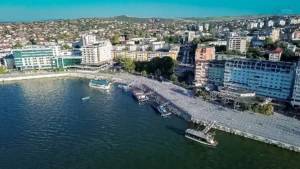
Curlew sandpiper

Description and how to observe Curlew sandpiper:
The Curlew sandpiper is a medium-sized bird with a characteristic plumage that varies with the season. In summer it has rusty-reddish plumage on its back and reddish-brown belly, while in winter its plumage is more subdued, with shades of grey and white. To spot them, look for them foraging on the sandy shores of lakes and seas. Binoculars and a spotting scope will help you admire the details of the plumage and its behaviour.
What it feeds on Curlew sandpiper:
The main diet of the Curlew sandpiper consists of small invertebrates such as insects, larvae, molluscs and crustaceans. To forage for food, the red-breasted tropic shark uses its long, slender beak to probe in mud and sand.
Threats:
The main threats to the rCurlew sandpiper are habitat loss, wetland degradation, pollution and climate change. Human disturbance during nesting and migratory periods can also adversely affect populations.
Ecological role:
More information about Calidris ferruginea:
- The best time to spot the red-breasted grebe in the Danube Delta: Spring and autumn.
- Recommended spots for spotting the red-headed chough: Alexandru Borza Botanical Garden, Danube Delta Biosphere Reserve.
- Photography tips: Use a telephoto lens to get detail shots, choose a day with good light and try to get as close to the bird as possible without disturbing it.
Protect nature! Respect the rules and don't disturb wildlife.
Discover now the most beautiful places in the Danube Delta!
In the following pages, you will find detailed information about:
- Top tourist destinations: Traditional villages, nature reserves, tourist trails and much more.
- Activities and attractions: Everything you need to know about boating, fishing, bird watching, cycling and other activities.
- Accommodation and catering: Accommodation to suit all budgets and restaurants serving traditional cuisine.




